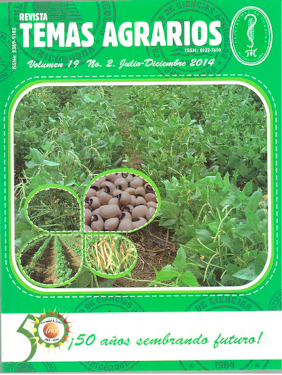Antioxidant activity and phenolic compounds concentration of tree tomato (Cyphomandra betacea S.) in postharvest
Actividad antioxidante y concentración de compuestos fenólicos del tomate de árbol (cyphomandra betacea s.) en poscosecha

This work is licensed under a Creative Commons Attribution-NonCommercial 4.0 International License.
Show authors biography
The Tree tomato (Cyphomandra betacea S.) is a fruit of mass consumption in Colombia, due to their special organoleptic and nutritional characteristics. Tree tomato fruits were evaluated for fifteen days during post- harvest stage to establish the evolution of antioxidant activity and concentration of phenolics compounds. The antioxidant capacity was analyzed by the ABTS method. It was found for the sixth day postharvest an average maximum value equivalent to 9.8 µmol of Trolox equivalents per gram of fresh fruit. Total phenols were determined by Folin Ciocalteu method, finding the highest concentration of phenolic compounds for the eighth day post-harvest, with 1.23 milligrams of gallic acid per gram of fresh fruit. The concentration of phenolic compounds was growing from day one of postharvest, then remained constant until day 11, showing a decrease to days 12 to 14 on ripening stage. In conclusion, it was established that the antioxidant activity in post harvest stage of tree tomato didn't present significant differences with a confidence level of 95%. The results obtained presented no positive correlation between antioxidant capacity and total phenolic concentration, however it was possible to conclude that tree tomato fruit is classified as a high antioxidant activity and good concentration of phenolic compounds compared to other fruits reported in various researches, aspects that power consumption of this species as a nutraceutical food.
Article visits 2749 | PDF visits
Downloads
- Bautista, R., Arévalo, M., Saucedo, C. y Martínez, D. 2005. Proceso de maduración de chicozapote (Manilkara sapota Royen) tipo fino. Revista Chapingo México, D.F. 11(2):387-391.
- Castro, H., Benelli, P., Ferreira, S. and Parada, F. 2013. Supercritical fluid extracts from tamarillo (Solanum betaceum S.) epicarp and its application as protectors against lipid oxidation of cooked beef meat. The Journal of Supercritical Fluids 76:17-23.
- García, M., De Pascual, T., Santos, B. and Rivas, G. 2004. Evaluation of the antioxidant properties of fruits. Food Chem 84:13- 18.
- Hollman, P., Hertog, M. and Katan, M. 1996. Analysis and health effects of flavonoids. Food Chem. 57: 43-46.
- Huang, D., Ou, B. and Prior, R. 2005. The chemistry behind antioxidant capacity assays. Journal Agricultural Food Chemistry 53:1841-1856.
- Instituto colombiano de normas técnicas. 1997. Icontec. NTC – 4105p.
- Kalt, W. and Dufour, D. 1997. Health functionality of blueberries. Hortechnolog 7:216-221.
- Kalt, W. 1999. Antioxidant capacity, phenolics and antocyanin after fresh storage of small fruits. En: J. Agric Food Chem 47:4638-4644.
- Kuskoski, M., Asuero, A., Troncoso, A. y Mancinifilho, J. 2005. Aplicación de diversos métodos químicos para determinar actividad antioxidante en pulpa de frutos. Ciencia y tecnología de alimentos 25(4):1-12.
- Márquez, L., Torres, F. y Pretell, V. 2007. Antocianinas totales, fenoles totales y actividad antioxidante en pulpas de frutas. Revista oficial de la Universidad Antenor Orrego 18(2):209-213.
- Ministerio de agricultura y desarrollo rural. Bogotá, D.C. 2014.
- Moo, H., Estrada, V., Estrada, I., Cuevas, R., Ortiz, L., Vargas E., Vargas M., Betancur, D. and Saur, E. 2014. Determination of some physicochemical characteristics, bioactive compounds and antioxidant activity of tropical fruits from Yucatan, Mexico. FoodChemistry 152:508-515.
- Murillo, F. 2006. Actividad antioxidante “in Vitro” de las bebidas de frutas. Universidad de Panamá, Instituto de Alimentación y Nutrición (IANUT), Laboratorio Bioquímica de Alimentos y Nutrición.
- Ordóñez, R., Vattuone, M. and Isla, M. 2005. Changes in carbohydrate content and related enzyme activity during (Cyphomandra betacea Sendt) fruit maturation. Postharvest Biology and Technology 35:293–301.
- Osorio, C., Franco, M., Castaño, M., González, M., Heredia, F. and Morales, A. 2007. Colour and flavour changes during osmotic dehydration of fruits. Innovative Food Science and Emerging Technologies 8:353-359.
- Otero, E. 2008. Cambios fisiológicos, texturales, fisicoquímicos y micro estructurales del tomate de árbol (Cyphomandra betacea S) en poscosecha. Tesis de Maestría en Ciencia y Tecnología de Alimentos. Facultad de Ciencias Agropecuarias, Universidad Nacional de Colombia, Medellín.
- Reque P., Steffens, R., Jablonski, A., Flôres, S., Rios, A. and De Jong, E. 2014. Cold storage of blueberry (Vaccinium spp.) fruit and juice: Anthocyanin stability and antioxidant activity. Journal of Food Composition and Analysis 33:111-116.
- Re, R., Pellegrini, N., Proteggente, A., Pannala, A., Yang, M. and Rice, C. 1999. Antioxidant activity applying an improved ABTS radical cationdecolorization assay. Free Radical Biology and Medicine 26:1231-1237.
- Repo, R. y Encina, C. 2008. Determinación de la actividad antioxidante y compuestos bioactivos de frutas nativas peruanas. Rev. Soc. Quim. Perú 74:108-124.
- Strail, P., Klejdus, B. and Kubán, V. 2007. Determination of phenolic compounds and their antioxidant activity in fruits and cereals. Talanta 71:1741-1751.
- Velioglu, Y., Mazza, G., Gao, L. and Omah, BD. 1998. Antioxidant activity and total phenolics in selected fruits, vegetables, and grain products. Journal of Agricultural Food Chemistry 46:4113-4117.
- Yang, C., Landau, J., Huang, M. and Newmark, H. 2001. Inhibition of carcinogenesis by dietary polyphenolic compounds. Annu. Rev. Nutr 21:381-406.
- Zapata, S., Piedrahita, A. y Rojano, B. 2014. Capacidad atrapadora de radicales oxígeno (ORAC) y fenoles totales de frutas y hortalizas de Colombia. Perspect. Nutr. Humana 16:25-36.




















